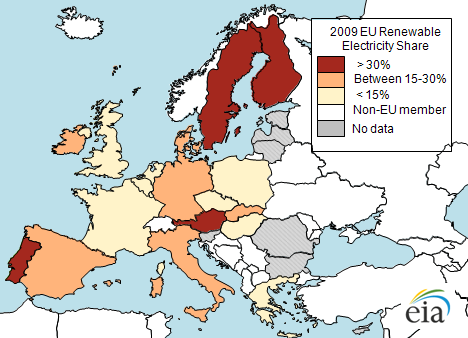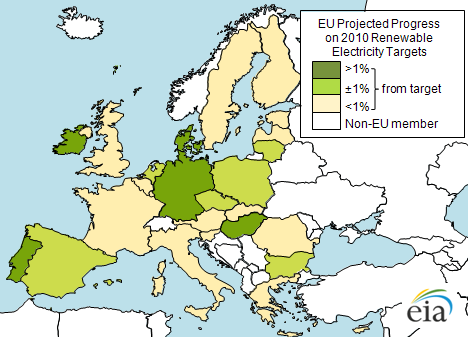
European Union countries reach for higher renewable electricity generation

Note: Data are for 2009. Renewable generation includes hydropower, biomass, wind, solar, and geothermal. Nuclear power is not included.
Many European Union (EU) countries have high penetration rates of renewable electricity, with an EU-wide average of 19% in 2009. The EU countries with the highest shares of renewable electricity generation in 2009 were Austria (74%), Sweden (60%), Portugal (39%), and Finland (32%). Hydropower and biomass played major roles in each of their renewable electricity generation mixes. In contrast, the United States generated 11% of its electricity from renewables that year. In the United States, the largest contribution comes from hydropower, followed by wind and biomass.
The United States does not have a national goal on renewable energy, although 29 states and the District of Columbia had legislated renewable portfolio standards as of June 2011 (an additional 8 states have renewable portfolio goals). The EU, on the other hand, has a legally binding goal to achieve a 20% renewable energy share of total energy consumption by 2020, which includes not only electricity, but also transportation, heating and cooling. In working towards this overall energy goal, each country individually set targets for its own share of renewable electricity and created action plans to attain that target. Of the 27 plans, 20 incorporated feed-in tariffs1, or FITs, to promote renewable electricity production. These have had varied success, however, with many countries now finding it difficult to balance these incentives against the increased energy cost to consumers.
A 2011 report by the European Commission showed that only seven European nations—Denmark, Germany, Hungary, Ireland, Lithuania, Poland, and Portugal—were expected to reach their interim 2010 targets for producing renewable electricity. Despite these preliminary 2010 results for electricity, almost half of EU members still plan to surpass their overall renewable energy targets by 2020 (including energy used for transportation, heating, and cooling).

Note: National estimates of 2010 renewable electricity share are based on data from 2009. The map differentiates between member countries who estimate that they will achieve a renewable share over 1% from their 2010 target (dark green), +/-1% from their target (light green), or under 1% from their target (yellow).
Footnote:
1 A feed-in tariff is a policy or law used to encourage particular types of electricity generation, often from renewable energy resources. A feed-in tariff (FIT) typically requires a host utility to purchase generation from qualified generators (such as specified renewable resources) under fixed terms (price, length of contract, and so forth). Although these fixed terms usually specify an above market price for electricity, some FIT-like programs, such as the program for "qualifying facilities" under the Public Utility Regulatory Policies Act of 1978 during the 1980's and 1990's specified terms based on a utility's "avoided cost" of generation. FIT programs are in common use in some parts of Western Europe, and can currently be found at the state or local level in some areas of the U.S.
Tags: biomass, electricity, emissions, Europe, geothermal, greenhouse gases, international, nuclear, policy, renewables